My first hiking trip taught me a crucial lesson. I stood at the trailhead, unprepared and nervous. I had forgotten half of the essential hiking gear I needed.
Years later, I’m sharing my hard-earned wisdom with you. The right gear can make or break your outdoor experience. The National Park Service stresses the importance of the “10 Essentials”.
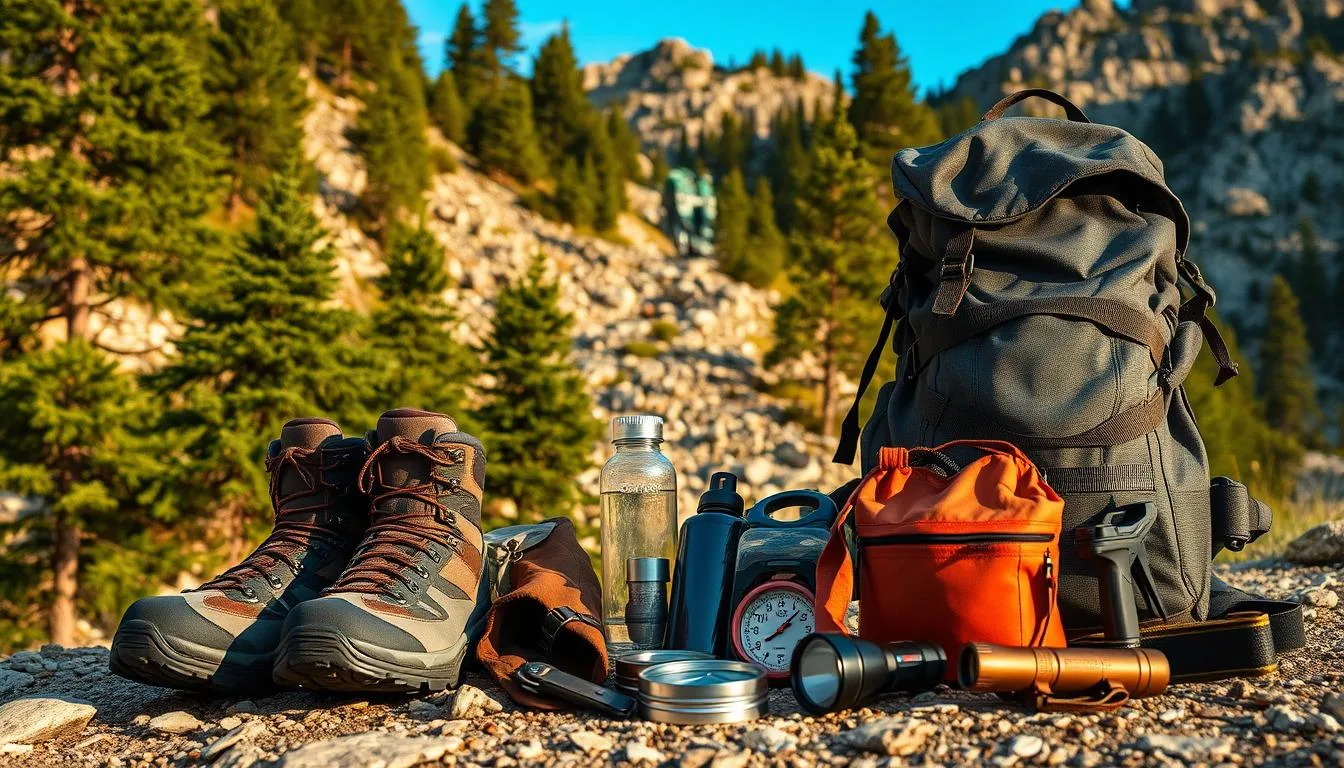
Each piece of equipment ensures your safety and comfort on the trail. Proper footwear with waterproof material and ankle support prevents blisters and injuries. A well-chosen backpack keeps your gear organized and accessible.
This guide covers must-have hiking gear items for every adventure. These essentials will enhance your hiking experience and prepare you for nature’s challenges. Let’s explore the gear you’ll need for your next outdoor trip.
Understanding the Importance of Essential Hiking Gear
Proper hiking gear is crucial for safety and enjoyment on the trails. Being prepared with the right equipment can make your adventure more comfortable and secure.
Why Having the Right Equipment Matters
Quality gear enhances your hiking experience. Good boots prevent blisters, while a reliable backpack distributes weight evenly. Trekking poles provide stability and reduce knee strain on long descents.
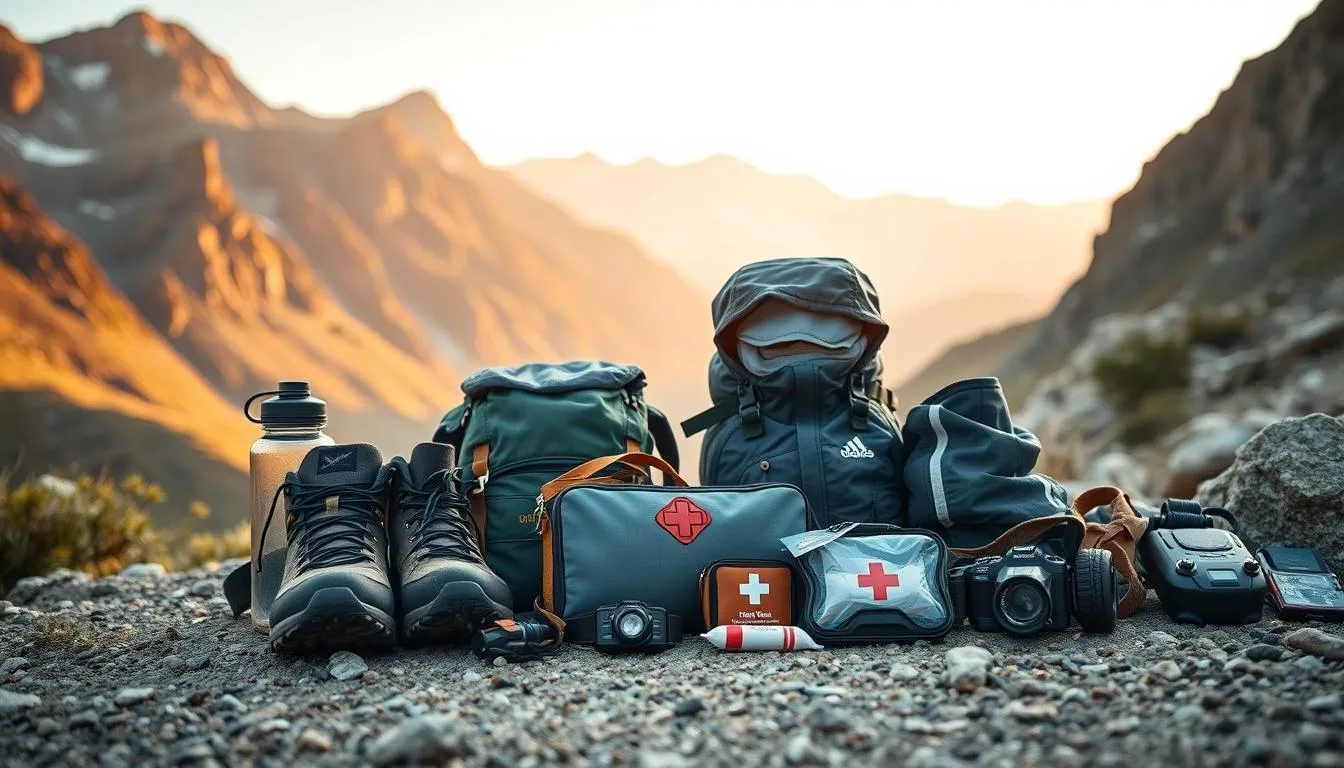
Safety Considerations for Every Hiker
Safety is paramount when hiking. A first aid kit is essential; I recommend the Adventure Medical Kits Ultralight/Watertight .5 Medical Kit. For emergencies, consider the Garmin inReach Mini satellite communicator.
Weight and Space Management
Balancing gear and pack weight is crucial. Choose multi-purpose items to save space. The Osprey Hikelite 18 backpack is ideal for day hikes.
For longer treks, the Osprey Tempest 20 Pack is a great option. A well-organized pack allows easy access to your hiking essentials on the trail.
- Choose lightweight, durable gear
- Pack multi-functional items
- Organize your backpack for easy access
Focusing on these aspects will prepare you for your next hiking adventure. The right gear enhances your experience and keeps you safe in nature.
Navigation and Safety Tools
Proper navigation tools are vital for safe hiking adventures. A map and compass are essential primary aids. These tools work in any weather and don’t need batteries.
Learning to read topographical maps and use a compass takes practice. However, it’s a crucial skill for every hiker to master.
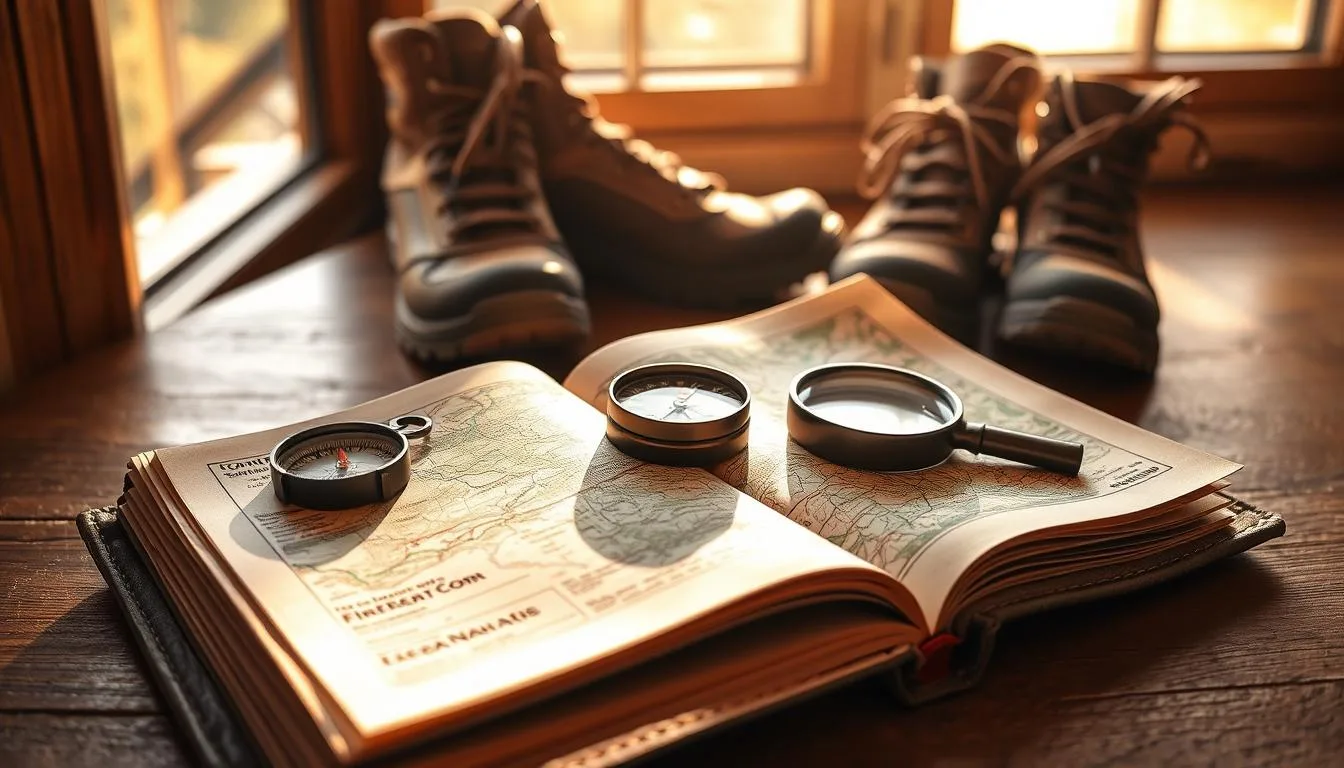
GPS Devices and Mobile Apps
Modern technology complements traditional methods. GPS devices offer precise tracking and can store multiple routes. Hiking apps like AllTrails provide detailed trail info and offline maps.
Always carry a spare battery pack to keep devices charged. This ensures you have access to digital navigation tools throughout your hike.
Emergency Communication
Safety is crucial in the wilderness. Never hike without an emergency communication device. Satellite messengers like Garmin inReach allow SOS signals from remote areas.
A basic whistle is also essential for signaling help in emergencies. It’s a simple tool that can make a big difference.
Practice using your gear before each hike. Always carry a first-aid kit. Proper preparation ensures safe navigation and worry-free nature enjoyment.
- Map and compass for reliable navigation
- GPS device or smartphone with hiking apps
- Satellite messenger for emergency communication
- Headlamp for safe navigation in low light
- First-aid kit for unexpected medical needs
With these tools and your hiking boots, you’re ready to tackle any trail confidently. Happy hiking!
Hiking Gear Essentials for Weather Protection
Weather can be unpredictable on the trail. Packing the right gear keeps you comfortable and safe. Let’s look at essentials for various hiking conditions.
Rain Gear and Waterproof Equipment
Quality rain gear is a must for staying dry. The REI Co-op Trailmade Rain Pants are lightweight and waterproof. A good jacket completes your rain protection setup.
The Zpacks Lotus UL Umbrella is a versatile tool. It provides shelter from rain and shade from the sun.
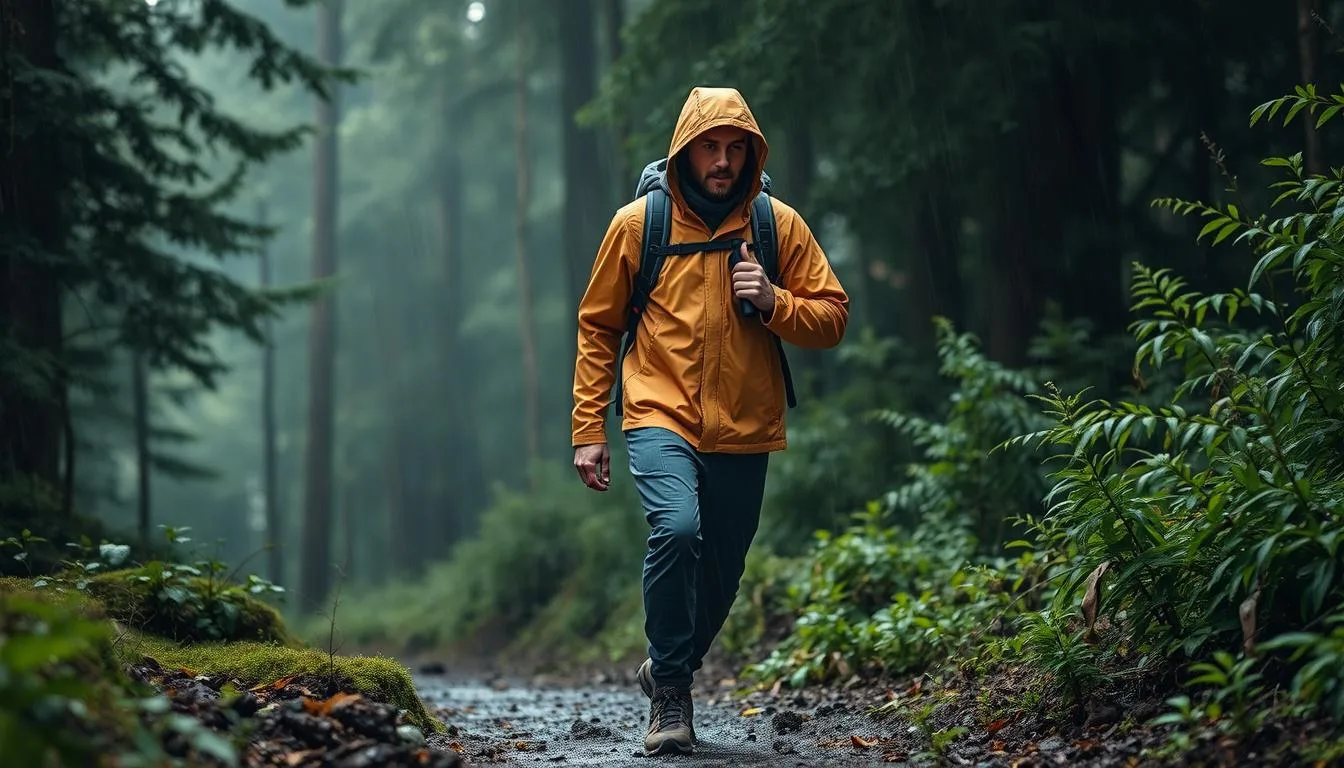
Sun Protection Essentials
Shielding yourself from the sun is vital. Pack sunscreen, a wide-brimmed hat, and sunglasses for your hikes. The Sunday Afternoons Ultra Adventure Storm Hat offers excellent protection.
This hat guards against sun and rain. It’s adjustable and perfect for changing weather conditions.
Temperature Control Layers
Layering helps manage your body temperature. Start with moisture-wicking clothes as a base layer. Add insulating layers like thermal inners for warmth.
Top it off with a waterproof jacket. For cold weather, pack insulated gloves and woolen socks. Bring water bottles to stay hydrated.
- Base layer: Moisture-wicking hiking clothes
- Mid layer: Thermal inners for insulation
- Outer layer: Waterproof jacket for wind and rain protection
- Accessories: Insulated gloves, woolen socks, and water bottles
Good gear can make your hike more enjoyable. Choose quality items that work well in all weather conditions.
Hydration and Nutrition Equipment
Proper hydration and nutrition are vital for a successful hike. I always pack the right gear to maintain energy levels. This equipment keeps my body functioning optimally during outdoor adventures.
Water Filtration Systems
Clean water is essential for hiking. I never forget my reliable filtration system. Iodine tablets, UV light purifiers, or portable filters are excellent choices.
These methods prevent illnesses like Giardia. They ensure safe drinking water from natural sources on the trail.
Hydration Bladders and Bottles
I prefer water bottles over hydration packs for their reliability. A 2-quart capacity is ideal for most hikes. For longer trips, I pack collapsible water containers to increase my carrying capacity.
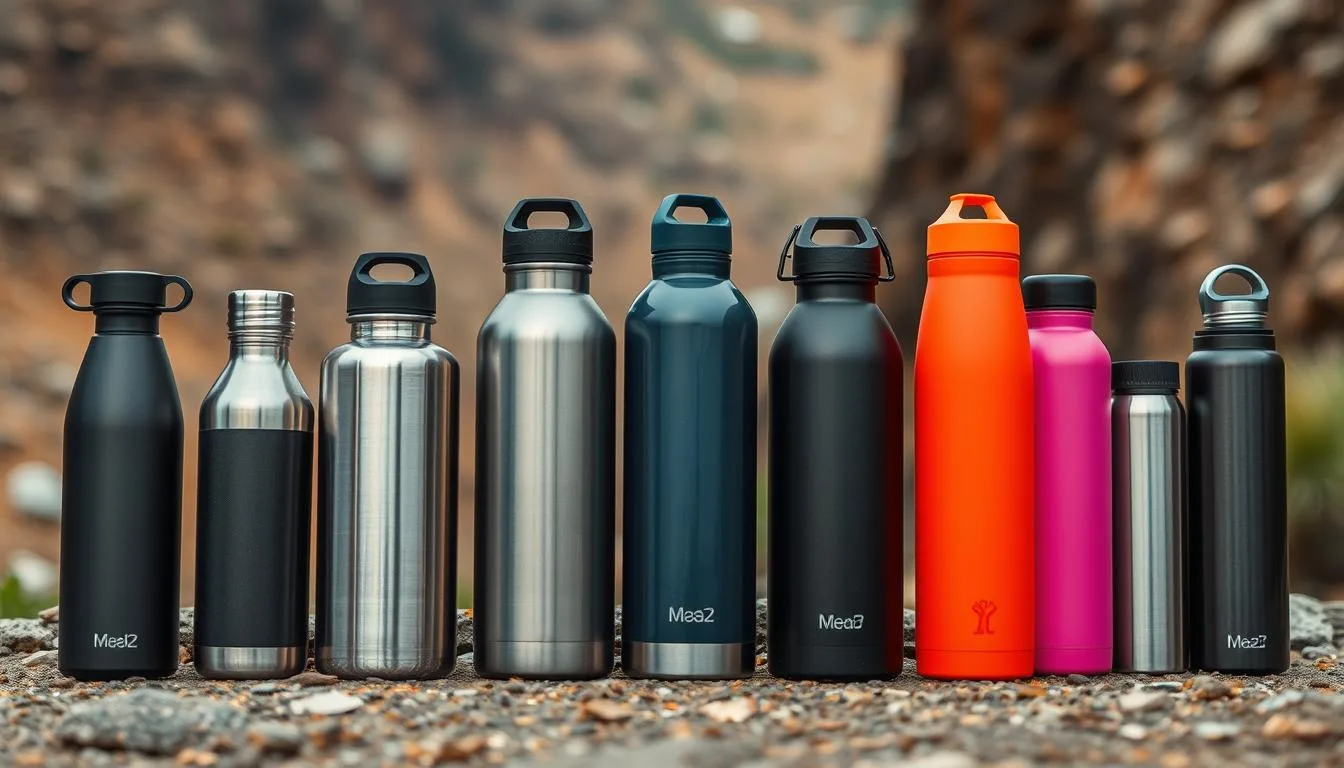
Food Storage Solutions
Proper food storage maintains energy levels during hikes. I pack lightweight, calorie-dense foods like energy bars, nuts, and trail mix. For extended trips, I bring a camping stove for hot meals.
Here’s my typical food packing list:
- Ready-made meals
- Energy bars
- Hydration mixes
- Easy-to-carry snacks
I carry 0.7 kg – 1 kg of food per day. This amount depends on my planned activity level. It provides enough calories (180-370 kcal per hour) to fuel my hike.
Staying hydrated is crucial during a hike. I drink 1 cup of water every 10-20 minutes. With the right gear, I’m always prepared for trail adventures.
Essential Emergency and First Aid Supplies
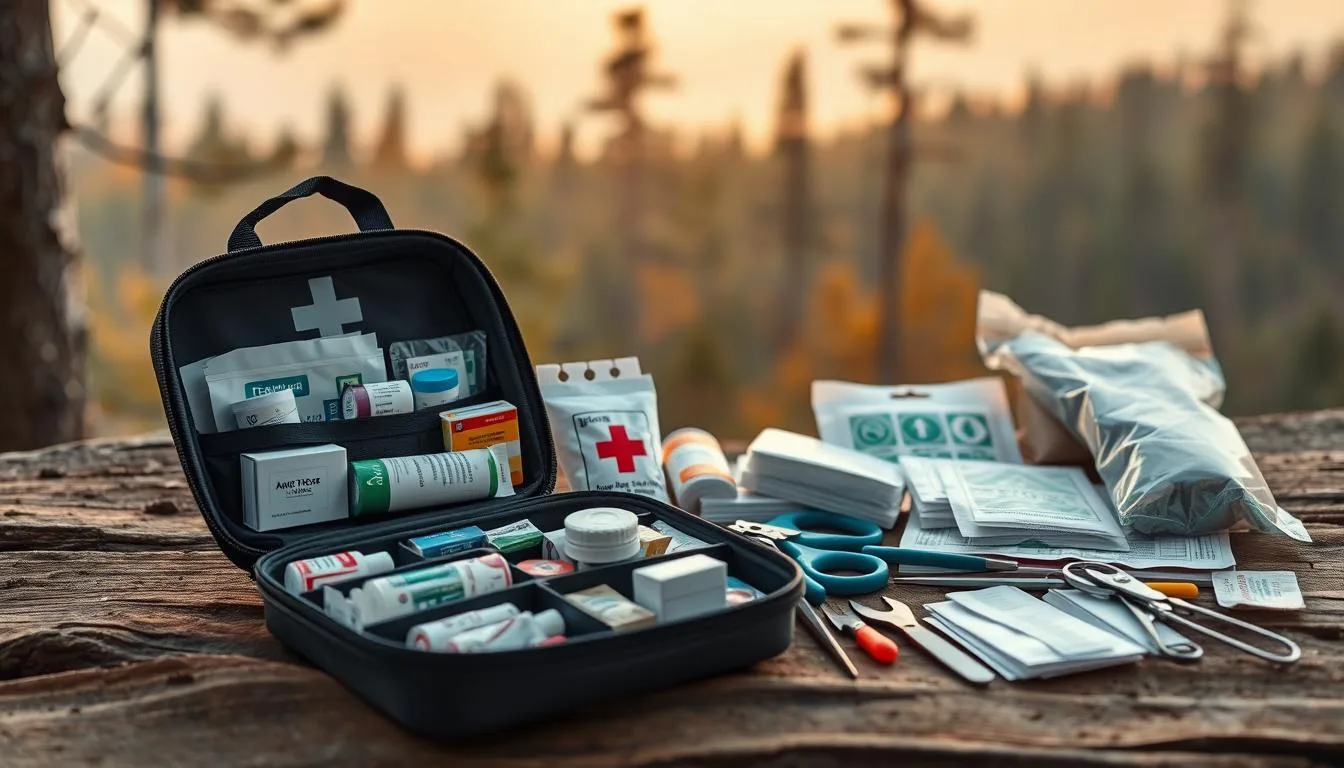
A well-stocked first aid kit is vital for handling hiking injuries and emergencies. The National Park Service suggests customizing your kit for your needs and trip length. I always pack a comprehensive kit for my trail adventures.
My first aid kit contains:
- Adhesive bandages in various sizes
- Sterile gauze pads and rolls
- Antiseptic wipes and antibiotic ointment
- Pain relievers and antihistamines
- Moleskin for blister prevention
- Tweezers and scissors
- Emergency blanket
I also carry a multi-tool and headlamps for added safety. Headlamps help with navigation in low light and can be lifesavers. Check your supplies often and replace expired items.
Knowing how to use your kit is as crucial as having one. Take a wilderness first aid course to learn proper injury treatment techniques. This knowledge can be a game-changer in emergencies.
I always bring extra emergency supplies like a whistle for signaling. A waterproof container for medications is also essential. These small items can make a big difference in unexpected situations.
Illumination and Fire Starting Tools
Reliable lighting and fire-starting gear are vital for hiking safety. These tools can be lifesavers in the wilderness.
Headlamps and Backup Lighting
Headlamps offer hands-free illumination for hiking. I prefer adjustable LED headlamps that last hundreds of hours. A smaller LED headlamp and extra batteries serve as backup.
It’s wise to practice changing batteries in the dark. This skill can be crucial in emergencies.
Fire Starting Equipment
Fire starting tools are essential. I pack:
- Windproof lighter
- Waterproof matches
- Firestarter for challenging conditions
- Vaseline-soaked cotton balls as tinder
UCO Stormproof Matches ignite quickly and burn for 15 seconds. They work even after being submerged. The Sweetfire Strikeable Fire-Starter combines match and tinder in one piece.
Emergency Signal Devices
For emergencies, I carry a Light My Fire Swedish FireSteel. It’s eco-friendly and produces thousands of strikes. Always be careful to prevent wildfires.
Consider camping stoves with built-in igniters as backup fire sources. This dual-purpose gear can be invaluable in emergencies.
Hiking Footwear and Trekking Support
Your feet are crucial for a great hiking experience. The right footwear can make all the difference on the trails. Choose from ankle-supporting boots or lightweight trail runners for your adventure.
Sturdy hiking boots excel on rough terrain. They offer strong ankle support and handle challenging paths well. Trail running shoes are perfect for milder conditions and quick day hikes.
Weather affects footwear choice. Waterproof boots like the Merrell Moab 3 Mid work well in wet conditions. Hiking sandals are great for hot, dry days and quick-drying stream crossings.
Try on different styles before buying. Alternating lacing techniques can improve fit. Hiking-specific socks offer more cushioning and blister protection than regular cotton ones.
Trekking poles provide extra support on steep terrain. They’re especially helpful for hikers with joint issues. Good insoles, like SuperFeet Hike Support, can reduce foot fatigue on long treks.
These small details can turn a good hike into an unforgettable adventure. Prioritize comfort and support for your feet to enjoy the trails fully.
Conclusion
I’ve covered 10 must-have hiking gear essentials, from backpacks to emergency tools. The REI Co-op Flash 18 or 22 are affordable, lightweight options for your gear. Osprey Hydraulics Reservoir keeps you hydrated without extra weight.
Footwear is vital. Chaco ZX2 sandals offer great traction and support for various terrains. Pack a rain jacket for sudden weather changes. Avoid cotton socks to prevent blisters.
The Black Diamond Storm Headlamp is ideal for emergencies. My experience of getting lost taught me to always be prepared. Carry more gear than you think you’ll need.
The American Hiking Society stresses that proper gear helps maintain and conserve trails. These 10 items ensure your safety and peace of mind. New hikers should consider borrowing or renting gear first.
With this knowledge about hiking gear and backpacks, you’re set to explore trails safely. Happy hiking!
FAQ
What are the absolute essentials I should pack for a day hike?
Pack these essentials for a day hike: backpack, water, snacks, and first aid kit. Include a map, compass, sun protection, extra clothes, and a headlamp. Don’t forget a fire starter and emergency shelter.
How do I choose the right hiking boots?
Pick boots based on terrain, trip length, and comfort. Look for good ankle support and waterproofing if needed. Try on boots with hiking socks and walk around.
Make sure there’s no slipping or pinching. Break in new boots before a long hike.
What type of water filtration system should I use while hiking?
Hikers have several water filtration options. Lightweight squeeze or gravity filters are efficient and easy to use. These quickly provide safe drinking water from natural sources.
Are trekking poles really necessary?
Trekking poles offer extra stability and reduce impact on joints. They help with stream crossings and setting up lightweight tents. Poles are great for those with knee issues or heavy packs.
What should I include in my hiking first aid kit?
Pack bandages, gauze, tape, scissors, tweezers, and safety pins in your first aid kit. Include antiseptic wipes, antibiotic ointment, pain relief, and antihistamines. Add blister treatment and personal medications.
Don’t forget to include a small first aid manual.
How do I stay safe when hiking in bear country?
Carry bear spray and learn how to use it. Store food properly and make noise while hiking. Hike in groups when possible and stay aware of your surroundings.
If you see a bear, stay calm. Speak softly and back away slowly.
What’s the best way to navigate if my GPS device fails?
Always bring a physical map and compass as backup. Learn to use these tools before hiking. Know key landmarks and trail markers.
Tell someone your planned route before leaving. This helps if you don’t return on time.
How much water should I carry on a hike?
Carry about 1 liter of water for every 2 hours of hiking. Adjust based on weather, elevation, and personal needs. Bring extra water and a filtration system for longer hikes.
What type of clothing is best for hiking?
Use a layering system with moisture-wicking base layers and insulating mid-layers. Add a waterproof outer layer. Choose quick-drying synthetic or wool materials over cotton.
Pack extra socks and a warm hat for cooler weather.
How can I reduce the weight of my backpack without sacrificing essential gear?
Choose multi-use items and lightweight versions of essential gear. Pack only what you truly need. Opt for a light sleeping bag, tent, and freeze-dried meals.
Weigh an item’s importance against its weight and potential use.


